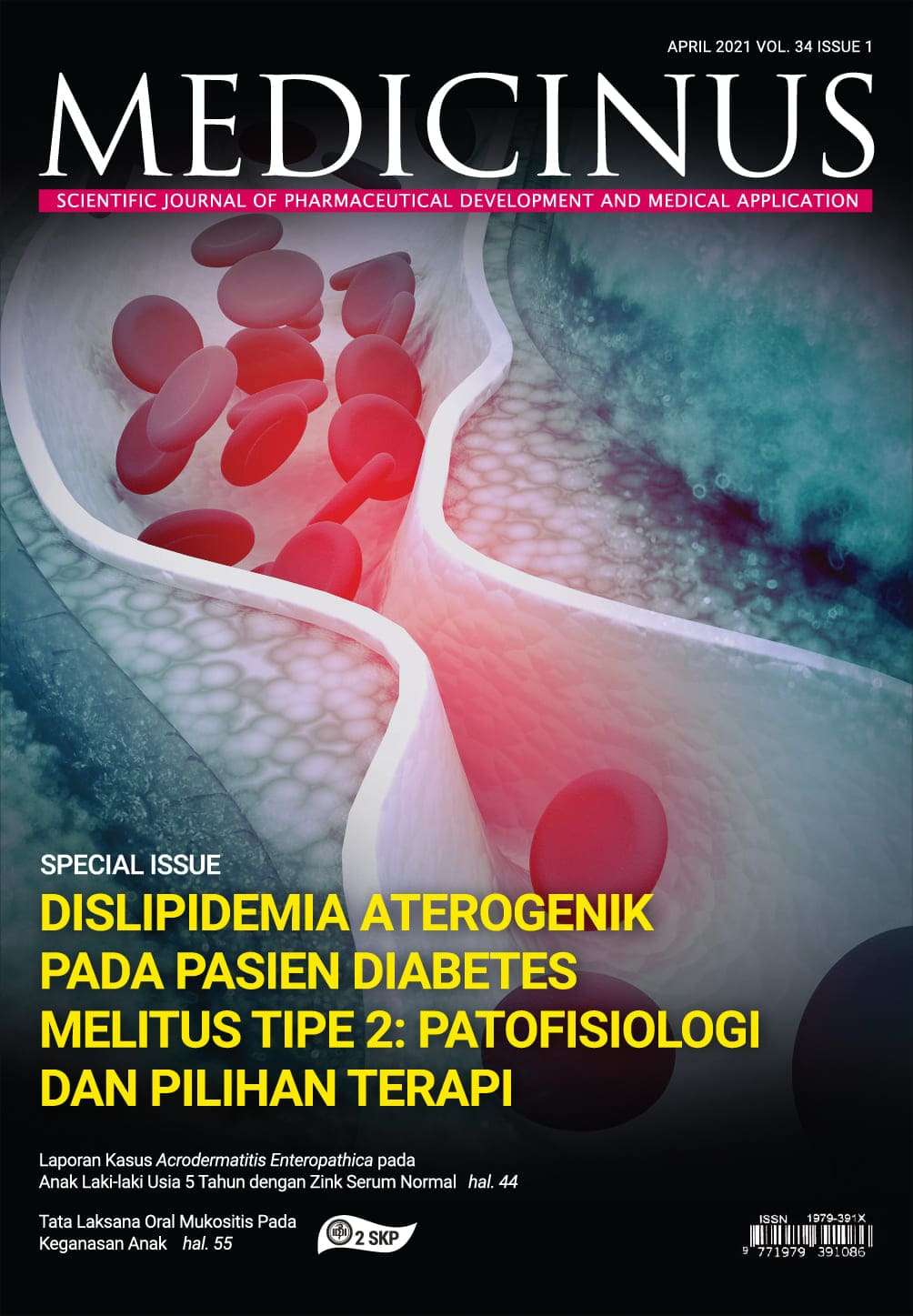Dislipidemia Aterogenik pada Pasien Diabetes Melitus Tipe 2: Patofisiologi dan Pilihan Terapi
DOI:
https://doi.org/10.56951/medicinus.v34i1.47Kata Kunci:
dislipidemia aterogenik, diabetes mellitusAbstrak
Dislipidemia aterogenik mempunyai karakteristik berupa peningkatan kadar trigliserida dan small dense low-density lipoprotein (sdLDL), serta penurunan kadar high-density lipoprotein (HDL). Kondisi ini disertai dengan peningkatan kadar dari very-low-density lipoprotein yang kaya akan trigliserida, apolipoprotein B, dan oxidized low-density lipoprotein (oxLDL). Profil lipid ini mempunyai peranan penting di dalam patogenesis gangguan kardiovaskular seperti penyakit jantung koroner, peripheral artery disease, dan stroke. Diabetes melitus adalah faktor risiko independen untuk terjadinya aterosklerosis prematur. Statin intensitas tinggi dan sedang (moderate) masih merupakan pilihan terapi yang direkomendasikan dalam tata laksana kelainan ini. Saat ini juga makin berkembang alternatif terapi di luar statin yang perannya masih mendampingi pemberian statin. Ezetimibe dan proprotein convertase subtilisin/kexin type 9 (PCSK9) inhibitor mulai banyak disebutkan dalam panduan penatalaksanaan dislipidemia terkini, selain tetap mengedepankan pendekatan nonfarmakologis seperti pengaturan diet dan latihan fisik.
Unduhan
Referensi
International Diabetes Federation Atlas 9th edition. www.diabetesatlas.org: IDF 2019.
International Diabetes Federation Atlas 7th edition www.diabetesatlas.org: IDF 2015. 3. Zheng Y, Ley SH, Hu FB. Global aetiology and epidemiology of type 2 diabetes mellitus and its complications. Nature Reviews Endocrinology 2017;14(2):88-98. DOI: https://doi.org/10.1038/nrendo.2017.151
Kothari V, Bornfeldt KE. A New Treatment Strategy for Diabetic Dyslipidemia? Diabetes 2020;69:2061-3. DOI: https://doi.org/10.2337/dbi20-0035
Manjunath CN, Rawal JR, Irani PM, Madhu K. Atherogenic dyslipidemia. Indian Journal of Endocrinology and Metabolism 2013;17(6): 969-76. DOI: https://doi.org/10.4103/2230-8210.122600
Li Y, Zhao L, Yu D, Ding G. The prevalence and risk factors of dyslipidemia in different diabetic progression stages among middle-aged and elderly populations in China. Plos One 2018;13(10):e0205709. DOI: https://doi.org/10.1371/journal.pone.0205709
Das H, Banik S. Prevalence of dyslipidemia among the diabetic patients in southern Bangladesh: A cross-sectional study. Diabetes & metabolic syndrome 2019;13(1):252-7. DOI: https://doi.org/10.1016/j.dsx.2018.09.006
Soebardi S, Purnamasari D, Oemardi M, Soewondo P, Waspadji S, Soegondo S. Dyslipidemia in newly diagnosed diabetes mellitus: The Jakarta primary non-communicable disease risk factors surveillance 2006. Acta medica Indonesiana 2009;41:186-90.
American Diabetes Association. Diagnosis and Classification of Diabetes Mellitus. Diabetes Care 2010;33(Suppl 1):S62– 9. DOI: https://doi.org/10.2337/dc10-S062
Sattar N, Welsh P, Preiss D. The insulin resistance syndrome. In: Ralph A. DeFronzo, Ele Ferrannini, Paul Zimmet, K.George M.M. Alberti, editors. International Textbook of Diabetes Mellitus: John Wiley & Sons, Ltd; 2015. DOI: https://doi.org/10.1002/9781118387658.ch23
Wu L, Parhofer KG. Diabetic Dyslipidemia. Metabolism and Clinical and Experimental 2014;63:1469-79. DOI: https://doi.org/10.1016/j.metabol.2014.08.010
Taskinen M-R. Diabetic dyslipidaemia: from basic research to clinical practice. Diabetologia. 2003;46(6):733-49. DOI: https://doi.org/10.1007/s00125-003-1111-y
Manoria PC, Mullasari A, Chopra HK, Parashar SK, Dutta AL, Pinto B, et al. The nuances of atherogenic dyslipidemia in diabetes: Focus on triglycerides and current management strategies. Indian Heart Journal 2013;65:683-90. DOI: https://doi.org/10.1016/j.ihj.2013.10.015
PERKENI Pedoman Pengelolaan dislipidemia di Indonesia 2019.
Devaraj S, Ji I. Optimum lipid testing for diabetic patients to enhance clinical care. Diabetes & Metabolic Syndrome: Clinical Research & Reviews 2021;15:461-4. DOI: https://doi.org/10.1016/j.dsx.2021.02.004
Klein S, Sheard NF, Pi-Sunyer X, Daly A, Wylie-Rosett J, Kulkarni K, et al. Weight management through lifestyle modification for the prevention and management of type 2 diabetes: rationale and strategies. A statement of the American Diabetes Association, the North American Association for the Study of Obesity, and the American Society for Clinical Nutrition. The American Journal of Clinical Nutrition 2004;80(2):257-63. DOI: https://doi.org/10.1093/ajcn/80.2.257
Wing RR, Bolin P, Brancati FL, Bray GA, Clark JM, Coday M, et al. Cardiovascular effects of intensive lifestyle intervention in type 2 diabetes. The New England journal of medicine 2013;369(2):145-54. DOI: https://doi.org/10.1056/NEJMoa1212914
Kearney PM, Blackwell L, Collins R, Keech A, Simes J, Peto R, et al. Efficacy of cholesterol-lowering therapy in 18,686 people with diabetes in 14 randomised trials of statins: a meta-analysis. Lancet (London, England) 2008;371(9607):117- 25. DOI: https://doi.org/10.1016/S0140-6736(08)60104-X
Ng DS. Diabetic Dyslipidemia: From Evolving Pathophysiological Insight to Emerging Therapeutic Targets. Can J Diabetes 2013;32:319-26. DOI: https://doi.org/10.1016/j.jcjd.2013.07.062
Mazidi M, Rezaie P, Karimi E, Kengne AP. The effects of bile acid sequestrants on lipid profile and blood glucose concentrations: A systematic review and meta-analysis of randomized controlled trials. International Journal of Cardiology. 2017;227:850-7. DOI: https://doi.org/10.1016/j.ijcard.2016.10.011
Chapman MJ, Redfern JS, McGovern ME, Giral P. Niacin and fibrates in atherogenic dyslipidemia: Pharmacotherapy to reduce cardiovascular risk. Pharmacology & Therapeutics 2010;126(3):314-45. DOI: https://doi.org/10.1016/j.pharmthera.2010.01.008
The Task Force for the management of dyslipidaemias of the European Society of Cardiology (ESC) and European Atherosclerosis Society (EAS) 2019 ESC/EAS Guidelines for the management of dyslipidaemias: lipid modification to reduce cardiovascular risk. European Heart Journal 2020;41:111-88. DOI: https://doi.org/10.1093/eurheartj/ehz826
Sabatine MS, Giugliano RP, Keech AC, Honarpour N, Wiviott SD, Murphy SA, et al. Evolocumab and Clinical Outcomes in Patients with Cardiovascular Disease. New England Journal of Medicine 2017;376(18):1713-22. DOI: https://doi.org/10.1056/NEJMoa1615664
Schwartz GG, Steg PG, Szarek M, Bhatt DL, Bittner VA, Diaz R, et al. Alirocumab and Cardiovascular Outcomes after Acute Coronary Syndrome. The New England journal of medicine 2018;379(22):2097-107. DOI: https://doi.org/10.1056/NEJMoa1801174
Reiter-Brennan C, Ose AD, Uddin SMI. ACC/AHA lipid guidelines: Personalized care to prevent cardiovascular disease. Cleveland clinic journal of medicine 2020;87(4):231-9. DOI: https://doi.org/10.3949/ccjm.87a.19078
Rhee E-J, Kim HC, Lee EY, Song Y. 2018 Guidelines for the management of dyslipidemia. Korean J Intern Med. 2019;34:723-71. DOI: https://doi.org/10.3904/kjim.2019.188
Grundy SM, Stone NJ, Bailey AL, Beam C, Birtcher KK, Blumenthal RS, et al. 2018 AHA/ACC/AACVPR/AAPA/ABC/ ACPM/ADA/AGS/APhA/ASPC/NLA/PCNA Guideline on the Management of Blood Cholesterol. Journal of the American College of Cardiology. 2019;73(24):e285-350. DOI: https://doi.org/10.1016/j.jacc.2018.11.003
American Diabetes Association 10. Cardiovascular Disease and Risk Management: Standards of Medical Care in Diabetes—2021. Diabetes Care 2021;44(Supplement 1):S125-50. DOI: https://doi.org/10.2337/dc21-S010
Unduhan
Terbitan
Bagian
Diterbitkan
Unduhan
Lisensi
Hak Cipta (c) 2021 Rulli Rosandi

Artikel ini berlisensi Creative Commons Attribution-NonCommercial 4.0 International License.




